
Today Adobe is launching a new application that is called Adobe Digital Editions. Looking to build the e-book market and reach the millions of people who are still waiting for a proper e-book solution, Digital Editions is a lightweight, consumer-optimized software for reading and organizing e-books and other digital publications.
You can download the public beta of Adobe Digital Editions from the
Adobe Labs Web site.
Why isn't Adobe PDF and the Adobe Reader sufficient?
In 1993, Adobe introduced its Acrobat system utilizing the PDF format, which was a spinoff of the older PostScript format. Because of its ability to translate a document's original fonts, colors and images into a file that can be opened and read on most computer systems, Adobe PDF has become a staple of modern business. Nevertheless, while PDF is still the preferred format for paginated presentation today, it has failed to become a mobile solution and the universal standard for e-books.
The Adobe Reader software was originally developed for enterprises and knowledge workers. Many of its features are not needed by the regular e-book user; in fact, most of us agree that Adobe Reader feels clumsy, bloated, slow and unnecessarily resource-intensive. And it seems to get less suitable for e-books with each version upgrade.
Adobe Digital Editions: reading e-books with open standards
Adobe realized that while PDF is great for some things (for instance textbooks with complicated illustrations and sidebars), at certain times, there is the need to support reflowable content. While PDF can support reflow to some limited extent, it's not its strong suit. This is especially true for mobile devices, which are getting increasingly popular for reading e-books (like in the Far East) and for which reflowable content is a precondition. So until now, the average non-technical consumer was faced with a myriad of alternative choices, including MobiPocket PDB, Microsoft LIT, Sony BBeB, eReader PalmDoc, and other more obscure formats, making it almost impossible to figure out what e-book format makes sense for him. Also publishers have not been vastly amused by the higher cost involved to distribute in all these formats, especially when they had to pay e-book conversion houses on a per-title basis.
To address the problem of format confusion and DRM hassles rapidly and effectively, Adobe has joined the
IDPF and worked together with publishers, authors, hardware and software providers, service providers, retailers and organizations on a new document format, OEB, and a new ZIP-based container format,
OEBPS OCF, which are both based on open standards. You can read more about IDPF and its rival OpenReader in Bob Russell's excellent essay
The fight for a reflowable e-document standard. These proposed e-book standards are intended to enable consumers to buy any title from any source and view it on any e-book reader. In short: interoperability of e-book devices and formats - hopefully along with broader availability of content.
Which brings us to Adobe Digital Editions. It looks and feels a bit like the
New York Times reader Microsoft has been working on. The main difference: it's built on open standards. And unlike Adobe Reader, it feels more lightweight, consumer-optimized and is simpler to use.
There are two key views of the application: reading view and library view. The reading view presents itself with a very simple user interface, where you can perform easy searches (nothing complex like regular expressions), switch to various reading modes, and view the table of contents (if available). If you don't move your mouse for a few seconds, you'll get a full-screen experience with the user interface temporarily disappearing. Like in Acrobat Reader, you can pan and zoom to your liking. In the library view you have the ability to organize and adjust your content. For instance, you can sort by author, title and so forth. You can also roll over content to get information (through metadata associated with the books). It's again kept very simple to streamline the user experience and make reading more pleasureable.
While you can read normal PDF documents with Digital Editions, what's really new and interesting to us is its ability to work with "liquid" reflowable textual content. This type of content will make a lot more sense on a small screen, where text size and presentation (including vector-based graphics) is automatically adjusted to the limited screen size. In addition, Adobe uses Extensible Style Language-Formatting Objects (XSL-FO) as a tool to adapt the major page layout depending on a combination of font size and screen size. For instance, if you have enough screen and smaller font size, you get three columns; but if you increase the font size, you'll get only two columns; and if you make the screen size smaller; the reader will automatically reduce to one column.
Many people still think e-books = PDF. Adobe is going beyond it and I am sure it'll take a while to sink in.
Facts you should know:- lightweight, 2.5MB free download (it's 10 times smaller than Adobe Reader)
- seamless download and installation (no need to manually install the reader
- just click on read and it will seemingly install)
- download consists of a single executable (digitaleditions2x0.exe) which is when unpacked about 6.5MB in size
- automatic updates
- v1.0 release expected in early 2007
- cross-platform: Windows (available 10/24), Mac OS X and Linux in the works
- supports Adobe PDF, flowable XHTML-based content (OEB), Flash SWF for rich media (at some later stage)
- works online and offline
- remembers the last reading location and viewing mode for each e-book
- simple search / go to page x / chapters (if supported by the document)
- rendering technology is written in fast native C (and is the same rending code that is used for the Sony Reader)
- user-interface/skin is based on Flash/Flex
- works with existing Adobe Content Server eBook DRM and forthcoming hosted Digital Editions Protection Service
- no longer requires a separate DRM activation step as previously required with eBook DRM for Adobe Reader 7
Limitations (found in a private beta, build code r226d27):- no audio output (tested with "Shrek Sound FX Edition" e-book)
- no right mouse button context menu
- no annotations
- failed upon password-protected PDF (no error, just wouldn't open)
- no option to manually adjust the size or appearance of fonts for PDF documents
- lacks printing capabilities
- no manual control over column formatting at a given screen and font size
Roadmap:- social networking (ability to share annotations and reading lists among a group of people)
- browser-based operations (e.g. allow e-book retailers to offer sneak previews of e-books online)
- new hosted content protection service (with content for the consumer not glued to one particular device)
- contextual advertisement as a new business model for publishers
- "push" delivery of content subscriptions/webcasts
- mobile device versions of the software
- multimedia interactivity to create new reading experiences
Screenshots:
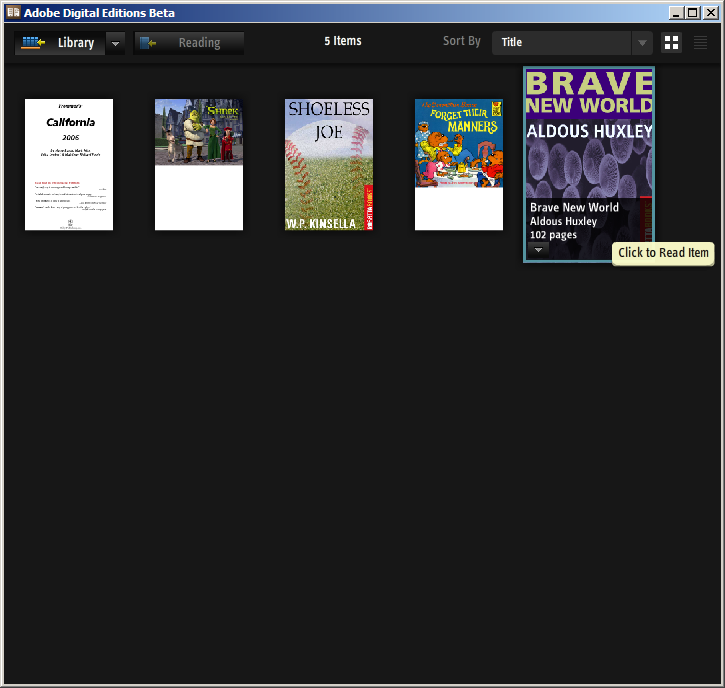 Library Thumbnail view
Library Thumbnail view
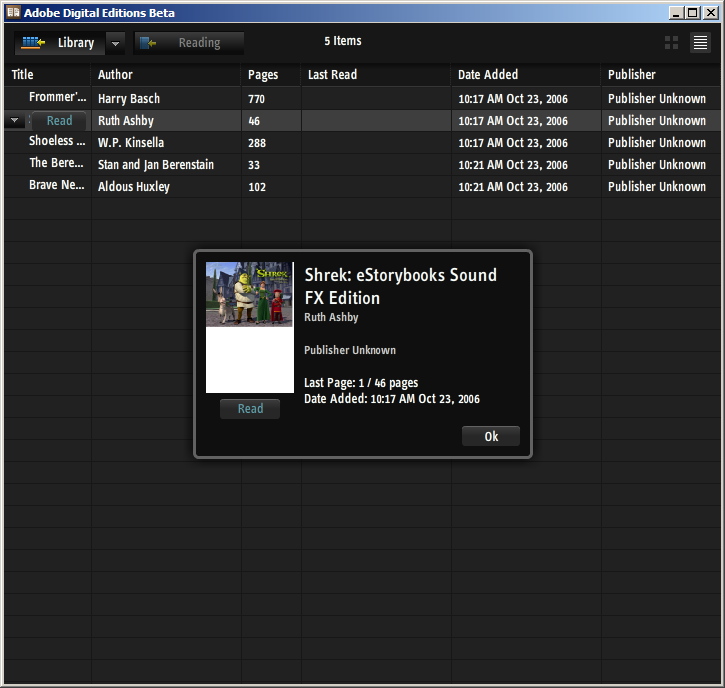 Library List view
Library List view
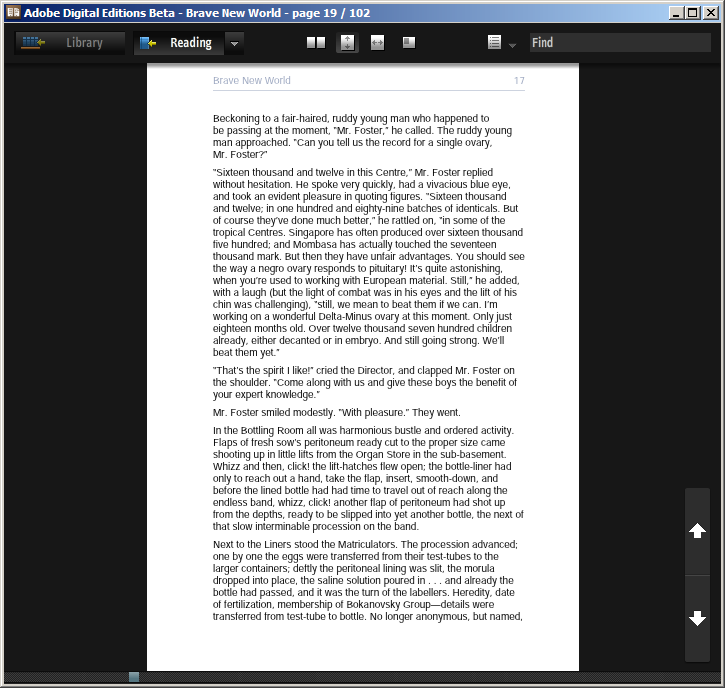 Reader Single Page view
Reader Single Page view
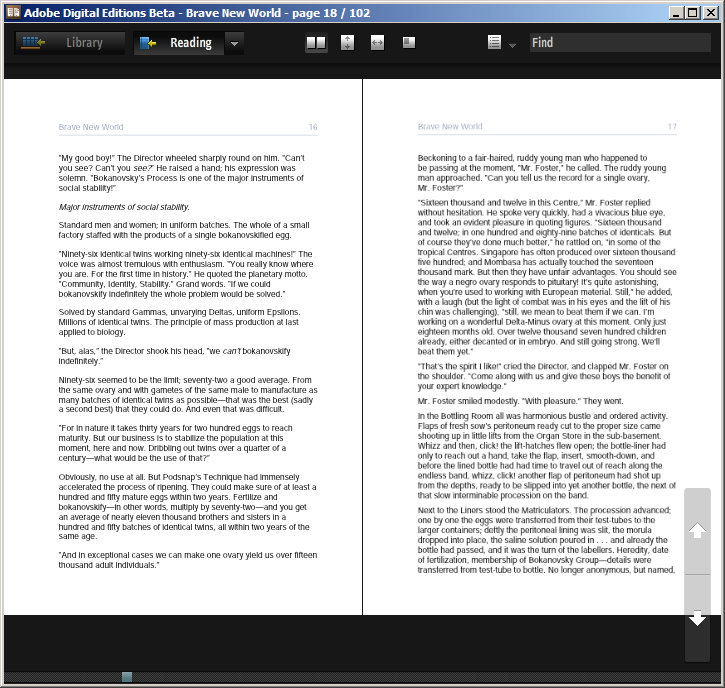 Reader Double Pages view
Reader Double Pages view
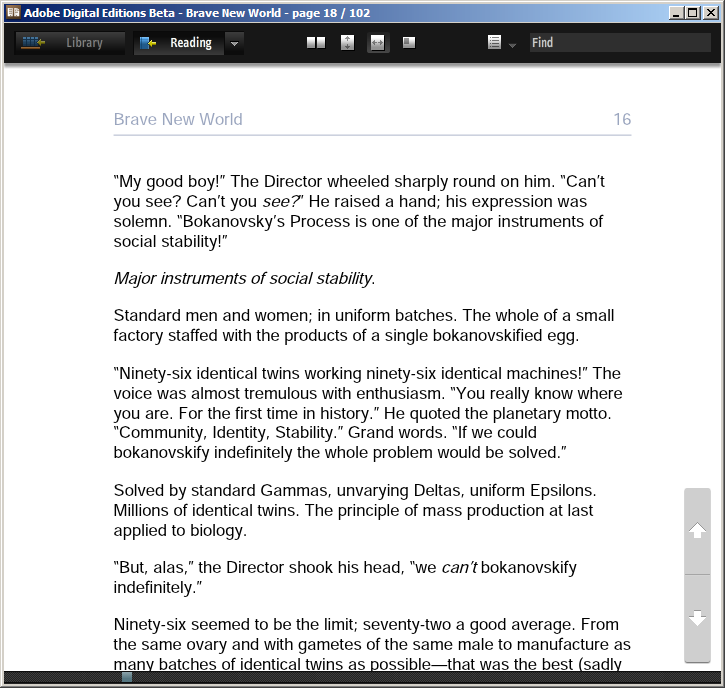 Reader Fit to Width view
Reader Fit to Width view
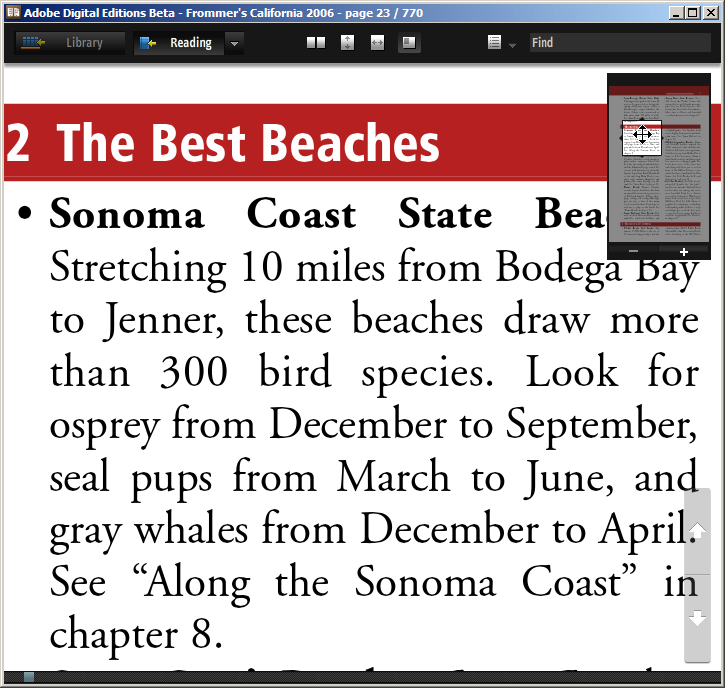 Reader Zoom view
Reader Zoom view
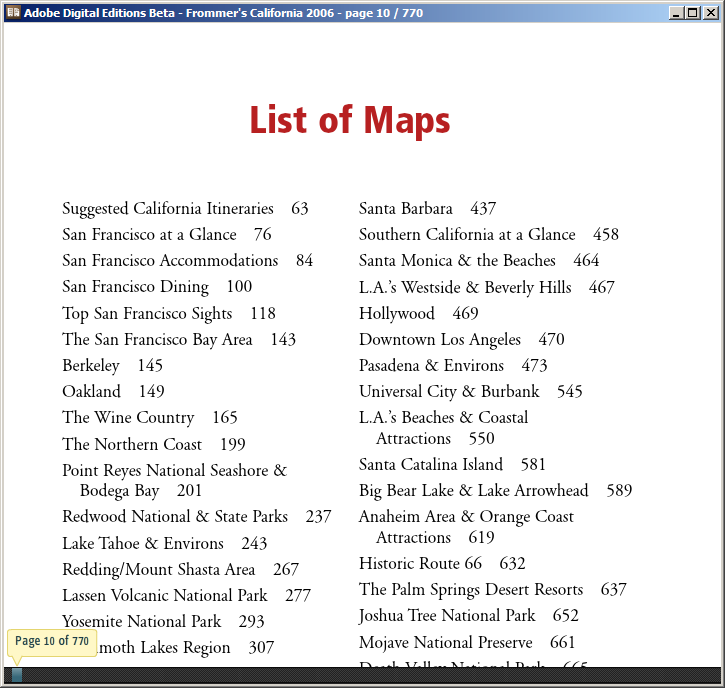 Reader Gui disabled
Reader Gui disabled
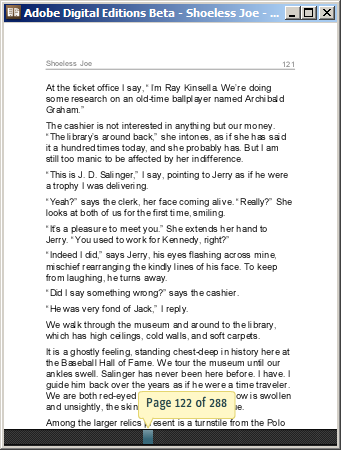 Resized PDF content
Resized PDF content
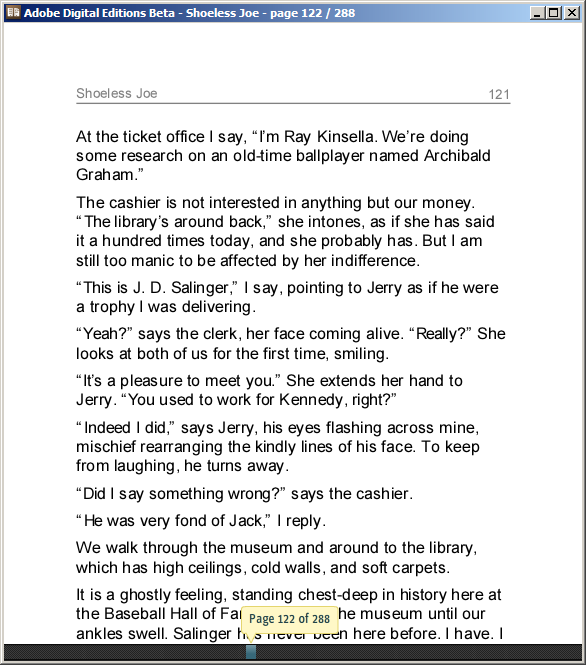 Resized PDF content
Resized PDF content
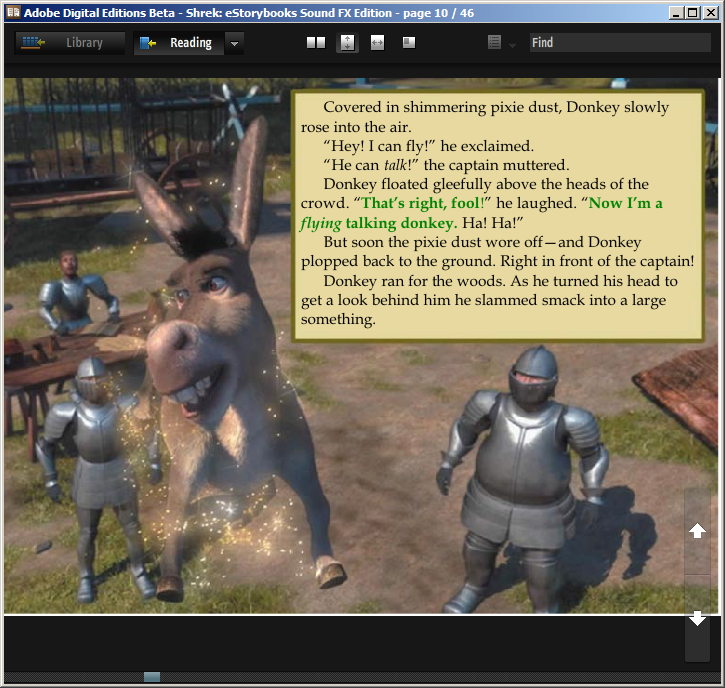 Illustrated PDF content
Illustrated PDF content